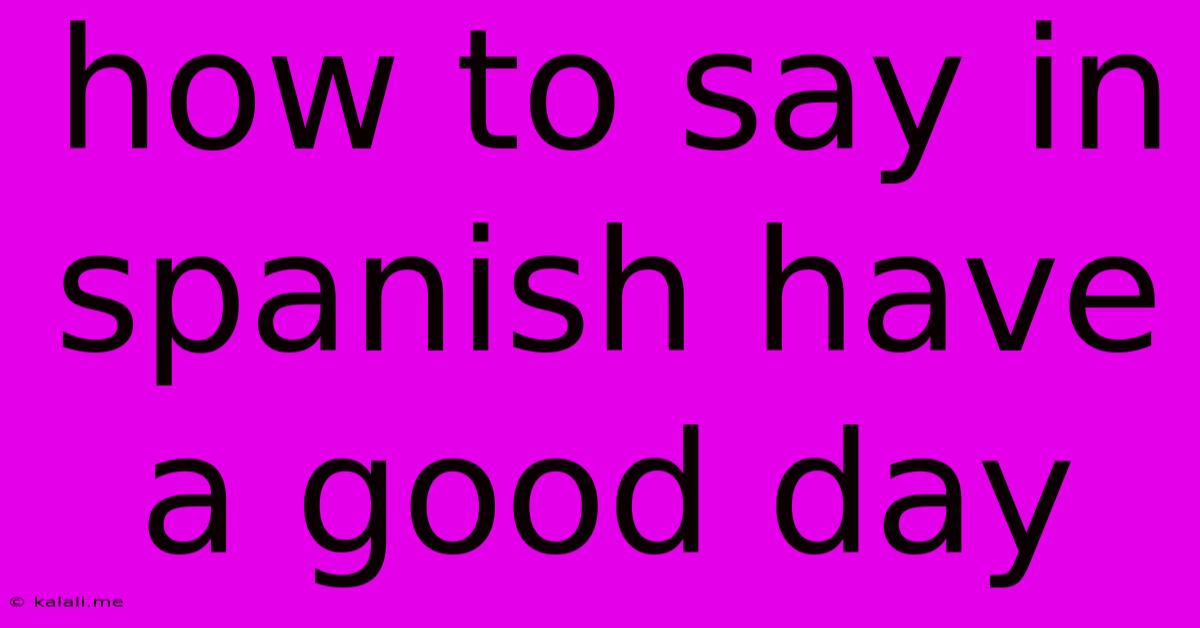How To Say In Spanish Have A Good Day
Kalali
May 20, 2025 · 3 min read

Table of Contents
How to Say "Have a Good Day" in Spanish: A Comprehensive Guide
Want to wish someone a pleasant day in Spanish? This guide explores various ways to say "Have a good day" in Spanish, depending on the context and level of formality. We'll cover common phrases, regional variations, and even some advanced options to elevate your Spanish conversational skills. This will help you confidently greet friends, colleagues, and strangers alike.
Formal Ways to Say "Have a Good Day" in Spanish
For professional settings or when speaking to someone you don't know well, it's best to stick to more formal expressions.
-
Que tenga un buen día: This is the most common and widely accepted formal way to say "Have a good day." It translates literally to "May you have a good day." The use of the subjunctive ("tenga") adds a touch of politeness and formality.
-
Que pase un buen día: Similar to the above, this translates to "May you spend a good day." This option also uses the subjunctive and conveys a slightly softer, more polite tone.
-
Buenos días: While literally translating to "Good morning," "Buenos días" is often used throughout the day, especially in formal settings as a general greeting that implicitly wishes someone a good day.
Informal Ways to Say "Have a Good Day" in Spanish
When chatting with friends, family, or close colleagues, you can opt for more casual and friendly expressions.
-
¡Que tengas un buen día!: This is the informal equivalent of "Que tenga un buen día," using the informal "tú" form of the verb. The exclamation point adds enthusiasm.
-
¡Buen día!: A shorter and more informal version, simply meaning "Good day!" It's perfectly acceptable in casual conversation.
-
¡Que te vaya bien!: This translates to "Have a good one!" or "Take care!" and is a versatile phrase suitable for various farewells, implicitly including a wish for a good day.
Regional Variations and Other Expressions
While the phrases above are widely understood across Spanish-speaking regions, slight variations exist. The specific vocabulary and sentence structure may differ depending on the country or even the region within a country. However, the core meaning remains consistent. Understanding these nuances enhances your ability to communicate effectively in diverse Spanish-speaking communities.
You might also encounter variations like:
-
¡Pásalo bien!: This translates to "Have a good time!" and is suitable for a more casual and fun farewell.
-
Que tengas un lindo día: This translates to "Have a beautiful day" and is a more poetic and affectionate way to express your well wishes.
Choosing the Right Phrase: Context is Key
The best way to say "Have a good day" in Spanish depends entirely on the context. Consider your relationship with the person you're speaking to, the setting, and the overall tone of your conversation. Mastering these nuances elevates your fluency and showcases cultural sensitivity.
Expanding Your Spanish Vocabulary
Learning different ways to express common phrases like "Have a good day" significantly improves your overall fluency in Spanish. Explore other greetings and farewells, and practice using them in different contexts to build your confidence and conversational skills. This consistent effort allows for seamless integration into diverse Spanish-speaking environments.
This comprehensive guide provides you with the tools to confidently and appropriately wish someone a good day in Spanish, no matter the situation. Practice these phrases, and you'll soon find yourself effortlessly incorporating them into your daily conversations.
Latest Posts
Latest Posts
-
Is An Integrated Masters A Postgraduate Degree
May 20, 2025
-
Convert Three Phase To Single Phase
May 20, 2025
-
Login Failed For User Token Identified Principal
May 20, 2025
-
Difference Between A 2 Stroke And A 4 Stroke
May 20, 2025
-
How To Add Songs To Ipod Without Itunes
May 20, 2025
Related Post
Thank you for visiting our website which covers about How To Say In Spanish Have A Good Day . We hope the information provided has been useful to you. Feel free to contact us if you have any questions or need further assistance. See you next time and don't miss to bookmark.